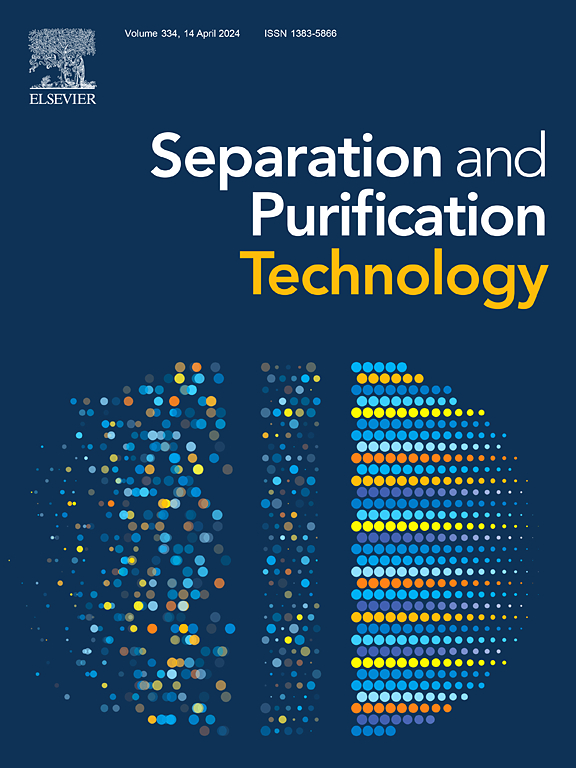去除烟气中的海洋氮氧化物、硫氧化物和二氧化碳:试点工厂的模拟和实验
IF 8.1
1区 工程技术
Q1 ENGINEERING, CHEMICAL
引用次数: 0
摘要
烟气处理通常涉及多个洗涤和吸收阶段,这不仅增加了资本和运营成本,而且需要很大的空间;对于空间有限的船舶来说,这种工艺尤其具有挑战性。为解决这一问题,一种高度实用、紧凑、高效、强化的柴油发动机船用工艺可同时去除氮氧化物和硫氧化物,以满足当前国际海事组织 MARPOL VI 14 关于 SECA 的规定和国际海事组织 MARPOL Annex VI Tier III 关于 NECA 的规定,并在压缩和液化之前捕获二氧化碳,以满足国际海事组织的新规定。拟议的方法在方形船用洗涤器中使用 NO 臭氧和 NaOH 湿法洗涤,从而减少了体积、重量、压降和相关成本。混合溶剂、多进料、富溶剂回收和热集成被用来加强二氧化碳的去除。船用柴油机烟气中试洗涤器的实验结果与 Aspen Plus V12 模拟结果吻合。此外,二氧化硫吸收效率为 97.0%,二氧化氮去除效率为 92.2%,二氧化碳去除效率从 87.4% 提高到 94.5%。与基本方案相比,汽提再沸器的功率降至 176 千瓦(节省 82.2%),总运行成本(TOC)和总年成本(TAC)分别降低了 56.3% 和 13.9%。本文章由计算机程序翻译,如有差异,请以英文原文为准。
Removal of marine NOx, SOx, and CO2 from flue gas: Simulation and experiment on a pilot plant
Flue gas treatment typically involves multiple scrubbing and absorbing stages, which increases capital and operating costs and requires large spaces; this process is particularly challenging for space-constrained ships. To address this issue, a highly practical, compact, efficient, intensified marine process for a diesel engine that simultaneously removes NOx and SOx to meet the current IMO MARPOL VI 14 regulations for SECAs and IMO MARPOL Annex VI Tier III for NECAs and captures CO2 before compressing and liquefying it to comply with new IMO regulations. The proposed method uses NO ozonation and wet scrubbing with NaOH in a square marine scrubber, which reduces volume, weight, pressure drop, and associated costs. Mixed solvents, multiple feeds, rich solvent recycling, and heat integration were used to intensify CO2 removal. Experimental results with a pilot scrubber on marine diesel engine flue gas agreed well with the results of Aspen Plus V12 simulations. Moreover, SO2 absorption efficiency was > 97.0 %, NO2 removal efficiency was > 92.2 %, and CO2 removal efficiency increased from 87.4 % to 94.5 %. The stripper reboiler duty reduced to 38 kW (82.2 % savings) and the total operating costs (TOC) and total annual costs (TAC) reduced by 56.3 % and 13.9 %, respectively, compared with those of the base case.
求助全文
通过发布文献求助,成功后即可免费获取论文全文。
去求助
来源期刊

Separation and Purification Technology
工程技术-工程:化工
CiteScore
14.00
自引率
12.80%
发文量
2347
审稿时长
43 days
期刊介绍:
Separation and Purification Technology is a premier journal committed to sharing innovative methods for separation and purification in chemical and environmental engineering, encompassing both homogeneous solutions and heterogeneous mixtures. Our scope includes the separation and/or purification of liquids, vapors, and gases, as well as carbon capture and separation techniques. However, it's important to note that methods solely intended for analytical purposes are not within the scope of the journal. Additionally, disciplines such as soil science, polymer science, and metallurgy fall outside the purview of Separation and Purification Technology. Join us in advancing the field of separation and purification methods for sustainable solutions in chemical and environmental engineering.
 求助内容:
求助内容: 应助结果提醒方式:
应助结果提醒方式:


